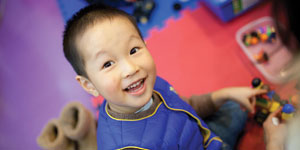Preschool
6 min Read
Montessori and other nursery school alternatives

August 13, 2014
Preschool
6 min Read

August 13, 2014

Deciding whether to send your toddler or preschool-aged child to nursery school can feel like a big decision, especially when some of the choices out there are untraditional.

That’s definitely the case with Montessori schools, despite being founded more than 100 years ago by Italian physician and educator Maria Montessori. Her brand of education is less focused on “teaching to the test” and more on child-centred experiential learning, independence, freedom within limits and learning according to each student’s own individual needs, developmental stage and interests.
‘‘It’s a progressive method of education that is even more relevant today than it was a century ago,” says Isabelle Kunicki-Carter, principal, founder and director of Forest Hill Montessori School in Toronto. “It caters to different learning styles and instills in children work habits, a love of learning and critical thinking skills while nurturing the creative mind – all necessary for success in the 21st century.’’
While Isabelle says that traditional classrooms tend to focus on rote learning, assessment and standardized test results, Montessori schools offer the opposite. She describes it as a collaborative approach to education that engages learners and focuses on the whole child rather than just on academics.
First, classes are grouped according to age groups, not grade – students 18 months to three years are at the toddler level. Three- to six-year-olds are in the primary grade and elementary level students are ages six to 12.
“This allows kids to learn at their own pace and offers more collaboration and a more natural learning environment,” says Isabelle. “Little kids look up to older students, and older students get to be leaders and gain confidence and responsibility.”
Class sizes follow a student-teacher ratio of 5:1 for the toddlers, 8:1 for primary students and 12:1 at the elementary level. Costs vary from school to school (each Montessori is independently owned), but generally can run from $10,000 a year for a half-day toddler program to $17,000 for full-day programs. There is no application process.
Montessori students focus on hands-on learning with field trips and an environment rich in experiences and collaborative learning.
“Children progress quickly in this environment,” Isabelle says. “Montessori students are engaged, they love learning and love school. Learning should always be fun. The world is a fascinating place,” she says.
Because it’s an alternative method of teaching, it requires a leap of faith on the part of the parent, says Isabelle.
Letty Wong took that leap when she registered her toddler five years ago to the Forest Hill Montessori School.
“I love the program,” says the mom of two boys, now five and seven. “It teaches practical life skills, independence and self reliance. They can take care of plants, set a table, prepare food. They even learn cooking in Grade 1. These skills are just as important as academics.”
Letty likes the “whole child” approach and how it lets kids go at their own pace without the pressure of having to learn certain things by a certain age. Classroom activities also allow children to go ahead of their class when they are ready. The program helped her older son gain social skills, and now he has lots of friends as well as confidence.
“I also like how the school works with parents. There is lots of communication and I speak to my kids’ teachers on a regular basis,” says Letty. “I’m not in the dark until parent-teacher interviews. I’m very happy we stumbled upon Montessori.”
Montessori isn’t the only alternative method of education for your little one. Check out these two popular approaches:
Originally published in ParentsCanada magazine, August/September 2014.
Find Montessori schools and Waldorf schools in Canada with ParentsCanada’s Private School Guide.